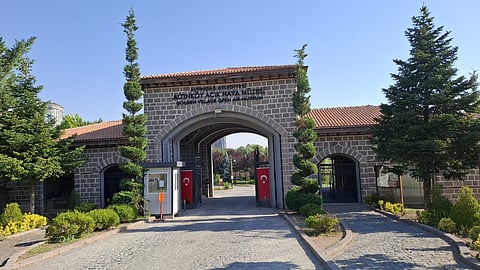

ANKARA (Turkiye): As one walks through the iron gates of the Altınköy Open Air Museum, nestled in Ankara’s Altındağ district, it feels as though the city melts away.
The hum of traffic fades into the gentle clucking of hens, the creak of a cartwheel, and the scent of fresh bread baking on stone stoves. Köy—the Turkish word for “village”—is no metaphor here.
Altınköy is not a staged heritage park but a living, breathing reimagination of the rural Anatolian life of the 1930s to 1950s.
For many urban dwellers in Turkey today—much like in Kashmir—village life is a memory. As cities swell and traditions shrink, generations grow up with no idea how water mills work, how grain is stored in wooden bins, or how mornings once began with the call of a rooster rather than a smartphone alarm.
It is this collective forgetting that Altınköy gently resists.
Established in 2013 by the Altındağ Municipality, the museum stretches across 500 acres of land reclaimed from informal settlements. What now stands is a meticulously recreated rural world: a village mosque, schoolhouse, common village washroom or dhobighat on a water channel, blacksmith’s forge, coffeehouse, stables, orchards, and homes decorated with objects sourced from across Anatolia—many of which are no longer made, let alone used.
Visiting Altınköy is like stepping into the memory of someone’s grandmother.
As I wandered the winding dirt paths, pausing by a wooden rahat that lifts water from a stream to irrigate uphill terraces, I could not help but feel both awe and melancholy.
Having spent some days of childhood away from Sopore in a remote district, the village of Taratpura in Ramhal region, this was not just about recalling aesthetics—it was about rhythm. A rhythm that today’s urban life has almost entirely lost.
The day began, as it does for most visitors, with a traditional Turkish breakfast.
It was served not in a sterile café but on low tables in open courtyards shaded by walnut, willow and chinar trees.
Village aunties (teyzeler) prepared everything in front of us—hand-rolled gözleme (stuffed flatbreads), fresh bazlama bread, and eggs fried over open flames. The food was a vivid celebration of simplicity: multiple varieties of cheese—some creamy, others aged and crumbling—thick honey served still in its comb, olives marinated in herbs, jams made from sour cherries and quince, and salads of cucumber and tomato harvested that very morning from nearby patches.
Even the tea had a taste different from the city’s—it had time in it.
Children laughed as they chased geese near the stream or fed sheep nibbling at the grass.
The iconic rope bridge hanging above the valley, the creaking water-powered panchaki that ground wheat into flour, and the flocks of birds darting above restored rooftops gave the place a rare authenticity. This was not a Disneyfied version of rural life—it was slow, textured, imperfect, and full of soul.
Old Farming Tools Hanging Against Stone Walls
Old farming tools leaned against stone walls; wool spinners sat beside clay stoves.
Inside each house, handwoven carpets lined wooden floors, copper utensils hung from walls, and lace curtains fluttered in the breeze. Many of these homes were relocated or rebuilt using original timbers from across Anatolia—living history made touchable.
And perhaps most striking is that Altınköy is not static. It hosts workshops, farming demonstrations, seasonal festivals, and even weddings. It sells locally made soap, honey, bread, and preserves. Here, heritage is not just displayed—it is used, worn, and tasted.
For someone from Kashmir, walking through Altınköy also stirs something deeper.
Ankara may not have Srinagar’s rivers or Mughal gardens, but the two cities share much in common. The climate is similar, the winters bite with the same frost, and the lakes surrounding Ankara—like Eymir and Mavi Göl—echo our own Dal and Nigeen in their calm allure.
Yet, in both places, urban sprawl threatens the soul of the countryside.
Srinagar too has seen its villages shrink into memory, its rice paddies replaced by concrete, and its old homes traded for prefab walls and tin roofs.
What if we built something like Altınköy in Kashmir? A living village-museum where children could see how rice was threshed, how kangris were made, how food was cooked over wood fires, or how our grandmothers spun by hand.
A place where the next generation can touch their roots—feel them, taste them, and carry them forward.
Altınköy is not just a museum. It is a bridge between past and present, between memory and modernity. It does not lecture—it invites. And in doing so, it reminds us that what we call “progress” should not mean forgetting who we are.
In its quiet, immersive way, it asks the question: can we ever be whole without the soil beneath our feet?
For city dwellers exhausted by glass towers and traffic noise, Altınköy offers something radical: the sound of a wooden door creaking open into a life where time moves with the sun.
And for Kashmiris, it sparks a longing—perhaps even a vision—to rediscover our own villages before they fade completely from view.
Have you liked the news article?